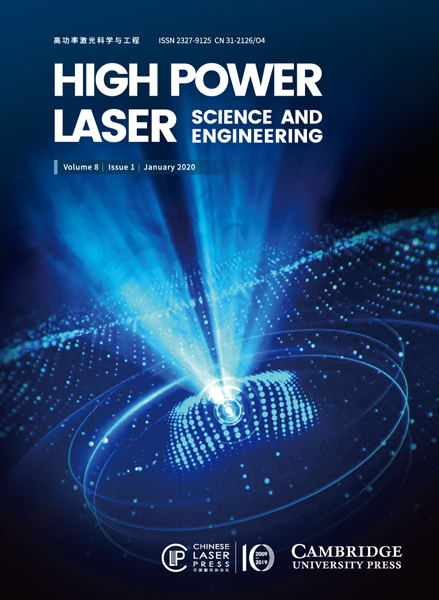2018, 6(1) Column
High Power Laser Science and Engineering 第6卷 第1期
Optimizing the cleanliness in multi-segment disk amplifiers based on vector flow schemes Download:771次
Download:771次
 Download:771次
Download:771次The objective of maintaining the cleanliness of the multi-segment disk amplifier in Shenguang-II (SG-II) is to reduce laser-induced damage for optics. The flow field of clean gas, which is used for the transportation of contaminant particles, is a key factor affecting the cleanliness level in the multi-segment disk amplifier. We developed a gas–solid coupling and three-dimensional flow numerical simulation model. The three-dimensional and two-phase flow model is verified by the flow-field smog experiment and the particle concentration measurement experiment with the 130-disk amplifier in SG-II. By optimizing the boundary conditions with the same flow rate, the multi-inlet vector flow scheme can not only effectively reduce the purging time, but also prevent the reverse diffusion of contaminant particles in the multi-segment disk amplifier and the deposition of contaminant particles on the surface of the Nd:glass.
cleanliness computational fluid dynamics flow field multi-segment disk amplifier vector flow Faraday effect measurements of holmium oxide (Ho2O3) ceramics-based magneto-optical materials, highly potential material candidates for high-energy laser Faraday isolators, are presented in this paper. Temperature dependence of the Verdet constant of nondoped Ho2O3 ceramics was measured for temperatures 15–305 K at $1.064~\unicode[STIX]{x03BC}\text{m}$ wavelength. The Verdet constant dispersion for wavelengths 0.5–$1~\unicode[STIX]{x03BC}\text{m}$ and $1.064~\unicode[STIX]{x03BC}\text{m}$ was measured for both nondoped Ho2O3 ceramics and Ho2O3 ceramics doped with terbium Tb3+ (0.2 at. %) and cerium Ce3+ (0.1 at. %) ions. The results suggest that the relatively low level of doping of Ho2O3 with these ions has no significant boosting impact on the Faraday effect. Therefore, other compositions of Ho2O3 ceramics-based magneto-optical materials, as well as various doping concentrations, should be further examined.
Faraday effect magneto-optics optical materials A new crystal spectrometer for application in X-ray opacity experiments is proposed. The conditions necessary to yield broad spectral coverage with a resolution ${>}$ 500, strong rejection of hard X-ray backgrounds and negligible source broadening for extended sources are formulated. In addition, the design, response modeling and reporting of an elliptical crystal spectrometer in conjunction with a linear detector are presented. The measured results demonstrate the performance of the new crystal spectrometer with a broad energy coverage range, high spectral resolution, and high luminosity (good collection efficiency). This spectrometer can be used in combination with point-projection backlighting techniques as utilized in X-ray opacity experiments. Specifically, the X-ray source, transmission and self-emission spectra of the sample can be measured simultaneously in a single shot, which can reduce the experimental uncertainties from shot-to-shot fluctuations. The new crystal spectrometer has been used in the X-ray opacity experiment to precisely measure the aluminum $K$ -absorption edge shift in the energy range around 1.560 keV in strongly compressed matter. It is demonstrated that the spectrometer can be used to realize measurements of new and unpredictable physical interactions of interest, as well as basic and applied high-energy-density science.
high energy density physics inertial confinement fusion ultra-intense ultra-short pulse laser interaction with matters We report a cavity-dumped 1123 nm laser with narrow pulse width and high peak power by an MgO: LN crystal electro-optic (EO) modulator. Based on the structural optimization design of a folded biconcave cavity using the 808 nm pulsed laser diode (LD) side-pumped ceramic Nd: YAG rod, output pulses with maximum pulse energy and peak power up to 39.6 mJ and 9.73 MW were obtained, corresponding to 100 Hz repetition rate and 4.07 ns pulse width. The instabilities of pulse width and pulse energy were $\pm$ 1.55% and $\pm$ 2.06%, respectively. At the highest repetition rate of 1 kHz, the pulse energy, pulse width, and peak power were 11.3 mJ, 5.05 ns, and 2.24 MW, respectively. The instabilities of pulse width and pulse energy were $\pm$ 2.65% and $\pm$ 3.47%, respectively.
cavity-dumped high peak power MgO: LN EO 1123?nm laser short pulse width Auto-alignment is a basic technique for high-power laser systems. Special techniques have been developed for laser systems because of their differing structures. This paper describes a new sensor for auto-alignment in a laser system, which can also serve as a reference in certain applications. The authors prove that all of the beam transfer information (position and pointing) can theoretically be monitored and recorded by the sensor. Furthermore, auto-alignment with a single lens sensor is demonstrated on a simple beam line, and the results indicate that effective auto-alignment is achieved.
auto-alignment high-power laser Directly writing binary multi-sector phase plates on fused silica using femtosecond laser Download:762次
Download:762次
 Download:762次
Download:762次Light carrying orbital angular momentum (OAM) has a spatial distribution of intensity and phase, which attracts considerable interest regarding several potential applications in optical and quantum scenarios recently. Spiral phase plates are commonly used elements for generating and analyzing OAM states. In this study, we put forward a method of directly writing binary multi-sector phase plates using the femtosecond laser. These phase plates are engraved on fused silica, which could be applied in high-intensity regimes. Different binary multi-sector phase plates were generated with high quality, which were proved by the observation of their structures, accompanied by detecting the beam patterns with the Gaussian beams. The proposed method provides a crucial basis for the rapid manufacturing of phase plates using convenient equipment, which can generate the superposition OAM states and may lead to the capability of measuring the high-dimensional entanglement.
femtosecond laser and applications optical fabrication; phase plate orbital angular momentum modes Enhanced acceleration of protons to high energy by relatively modest high power ultra-short laser pulses, interacting with snow micro-structured targets was recently proposed. A notably increased proton energy was attributed to a combination of several mechanisms such as localized enhancement of the laser field intensity near the tip of $1~\unicode[STIX]{x03BC}\text{m}$ size whisker and increase in the hot electron concentration near the tip. Moreover, the use of mass-limited target prevents undesirable spread of absorbed laser energy out of the interaction zone. With increasing laser intensity a Coulomb explosion of the positively charged whisker will occur. All these mechanisms are functions of the local density profile and strongly depend on the laser pre-pulse structure. To clarify the effect of the pre-pulse on the state of the snow micro-structured target at the time of interaction with the main pulse, we measured the optical damage threshold (ODT) of the snow targets. ODT of $0.4~\text{J}/\text{cm}^{2}$ was measured by irradiating snow micro-structured targets with 50 fs duration pulses of Ti:Sapphire laser.
high intensity laser ion acceleration optical damage threshold Temporal contrast is one of the crucial physical determinants which guarantee the successful performance of laser–matter interaction experiments. We generally reviewed the influences on the temporal contrast in three categories of noises based on the requirement by the physical mechanisms. The spatiotemporal influences on temporal contrast at the focal region of the chromatic aberration and propagation time difference introduced by large-aperture broadband spatial filters, which were spatiotemporally coupled with compression and focusing, were calculated and discussed with a practical case in SG-II 5 PW ultrashort petawatt laser. The system-wide spatiotemporal coupling existing in large-aperture broadband ultrashort petawatt lasers was proved to be one of the possible causes of temporal contrast degradation in the focal region.
chromatic aberration spatiotemporal coupling temporal contrast ultrashort petawatt lasers Corrosion behaviors of the copper alloy electrodes in ArF excimer laser operation process Download:540次
Download:540次
 Download:540次
Download:540次The corrosion behaviors of the ArF excimer laser copper alloy electrodes were studied. The morphology, composition and impurities were characterized by optical microscope, scanning electron microscopy, electron microprobe and glow discharge mass spectrometer methods. The anode produces the reef, the corrosion pits, the hole layer and the $1{-}10~\unicode[STIX]{x03BC}\text{m}$ level flake impurity. The cathode produces the particles, the sputtering pits, the element reduce layer and the $1~\unicode[STIX]{x03BC}\text{m}$ level particle impurity. Besides the Cu element, other elements in the alloy participate in the corrosion: Al element in the reef is over 1.5 times of the anode, Zn element in the particles is 1.3 times of the cathode, many trace elements congregate on the copper surface several and even hundreds of times. These elements are responsible to a great degree for the impurities and the rapid energy decline of the long-time idled laser.
ArF excimer laser corrosion behavior electrode impurity trace element The Shen-Guang II Upgrade (SG-II-U) laser facility consists of eight high-power nanosecond laser beams and one short-pulse picosecond petawatt laser. It is designed for the study of inertial confinement fusion (ICF), especially for conducting fast ignition (FI) research in China and other basic science experiments. To perform FI successfully with hohlraum targets containing a golden cone, the long-pulse beam and cylindrical hohlraum as well as the short-pulse beam and cone target alignment must satisfy tight specifications (30 and $20~\unicode[STIX]{x03BC}\text{m}$ rms for each case). To explore new ICF ignition targets with six laser entrance holes (LEHs), a rotation sensor was adapted to meet the requirements of a three-dimensional target and correct beam alignment. In this paper, the strategy for aligning the nanosecond beam based on target alignment sensor (TAS) is introduced and improved to meet requirements of the picosecond lasers and the new six LEHs hohlraum targets in the SG-II-U facility. The expected performance of the alignment system is presented, and the alignment error is also discussed.
laser drivers petawatt lasers spherical hohlraum target alignment target area Recent results in the development of diode-driven high energy, high repetition rate, picosecond lasers, including the demonstration of a cryogenic Yb:YAG active mirror amplifier that produces 1.5 J pulses at 500 Hz repetition rate (0.75 kW average power) are reviewed. These pulses are compressed resulting in the generation of ${\sim}5~\text{ps}$ duration, 1 J pulses with 0.5 kW average power. A full characterization of this high power cryogenic amplifier, including at-wavelength interferometry of the active region under ${>}1~\text{kW}$ average power pump conditions, is presented. An initial demonstration of operation at 1 kW average power (1 J, 1 kHz) is reported.
advanced laser technology and applications diode-pumped solid-state laser and applications high power laser high power laser related laser components laser amplifiers We present possible conceptual designs of a laser system for driving table-top free-electron lasers based on terahertz acceleration. After discussing the achievable performances of laser amplifiers with Yb:YAG at cryogenic and room temperature and Yb:YLF at cryogenic temperature, we present amplification modules with available results and concepts of amplifier chains based on these laser media. Their performances are discussed in light of the specifications for the tasks within the table-top light source. Technical and engineering challenges, such as cooling, control, synchronization and diagnostics, are outlined. Three concepts for the laser layout feeding the accelerator are eventually derived and presented.
concept free-electron laser lasers optics 动态信息
动态信息 丨 2023-06-21
HPL Highlight (Vol. 11, e40): NIF仍然是全球唯一一个能够进行ICF点火实验的装置动态信息 丨 2023-06-21
HPL Highlight (Vol. 11, e9): 变分神经网络预测激光尾波场加速电子能谱动态信息 丨 2023-06-21
HPL Highlight (Vol. 11, e7): 目标探测网络加入,激光等离子体加速器实现实时诊断动态信息 丨 2023-06-21
HPL Highlight (Vol. 11, e5): 910 nm波段超宽带种子源,向100 PW超强超短激光进发动态信息 丨 2023-06-21
HPL Highlight (Vol. 11, e4): 100 PW单束压缩!多步压缩器进阶双光栅激光评论微信公众号

点击菜单“联系编辑”即可添加期刊编辑为好友啦
















